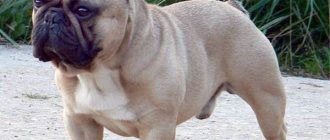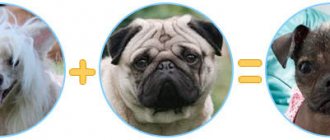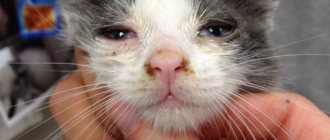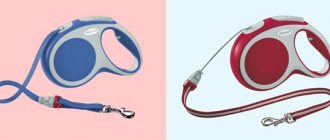Dog acne is one of the most common skin diseases: it is as common in four-legged pets as in humans. In most cases, the disease does not so much cause severe inconvenience to the animals themselves as it worries their owners, since acne is a serious cosmetic defect that spoils the appearance of pets.
Dogs need cosmetic procedures too
However, the loss of attractiveness is far from the most unpleasant thing: it has long been established that sometimes rashes appear against the background of serious pathologies, which without proper treatment can threaten not only the health, but also the life of the dog.
Locations of rashes
Acne can form on any part of a dog’s body, but places that are affected by additional negative factors are considered especially vulnerable:
- profuse sweating – skin folds, groin area and genitals (genitals);
- constant drooling – lips (sometimes mucous membrane), lower jaw and chin, cheeks, jowls;
- a tight collar, harness, muzzle or clothing - muzzle, neck, base of limbs, torso;
- frequent contact with infections - abdomen, mammary glands, ears, anus, area under the tail, phalanges of the fingers and the space between them.
Examples of localization of rashes: muzzle, paw and stomach
Important! Owners of dogs with long, thick hair need to be especially careful: in such breeds, acne begins to spread from the most “hairy” places, where they are very difficult to detect.
Types of rashes
As already mentioned, acne on a pug’s face can be of two types : primary, often a sign of an allergy or, in general, teenage acne and those caused by a secondary infection.
It is almost impossible for a non-specialist to determine what caused the dog’s acne, of course, unless the rash is accompanied by other symptoms, such as in the case of a food allergy.
But you can distinguish ordinary acne from those caused by a secondary infection at first glance . Normal acne looks like bumps on the skin, often reddish, but those rashes that appear due to the addition of a secondary infection are nothing more than pustular skin lesions.
How correctly the treatment will be prescribed also depends on the correct identification of the type of rash.
High-risk groups: which dogs get sick more often?
Some of the most acne-prone breeds are the pug and the beagle.
Some dog breeds, due to the characteristics of their biological structure, are more genetically predisposed to developing acne than others:
- with “wrinkled” skin - Shar-Pei, English Bulldogs, Pugs, Neapolitan Mastiffs (Mastino Neapoletano), Bullmastiffs, Basset Hounds, Dogues de Bordeaux;
- with webbed feet - Newfoundlands, Landseers, Portuguese Wasserhunds (Can-Diagua), Weimar pointers (Weimaraners), Otterhounds, Chesapeake Bay retrievers, German shorthaired pointers (shorthaired pointers);
- with smooth hair (smooth-haired) - dachshunds, toy terriers, Italian greyhounds, English greyhounds (greyhounds), pointers, bull terriers, Argentinean (Dogo-Argentino) and Great Danes, Dobermans, boxers;
- with residual fur (hairless) - Peruvian Inca dogs (viringo, calato), Chinese crested, Mexican hairless (xoloitzcuintle, xolo), American hairless terriers;
- with thick undercoat - Scottish (collie) and Caucasian shepherd dogs, Pekingese, chow-chow, Spitz, Samoyed huskies (Samoyeds), Bernese Mountain dogs, Tibetan mastiffs.
In the case of dogs with a very dense undercoat, the relevance of the concerns directly depends on the conditions of their keeping: if they constantly live in a hot, windless climate, then it is almost impossible to avoid the occurrence of inflammation.
Video - Skin diseases in dogs
Important! In male dogs castrated at an early age, the risk of developing “adult” acne increases many times over.
In outbred dogs (mongrels and mixed breeds), even when kept outdoors (in a kennel or enclosure), acne is extremely rare.
Diagnostics
To obtain a correct diagnosis, your pug must be seen by an experienced veterinarian. That being said, a good veterinarian should send your dog for tests to rule out other conditions that could lead to acne and to determine the cause and causative agent of the infection.
As a result of preliminary diagnosis, some diseases accompanied by similar symptoms can be excluded:
1. Some types of bacterial skin infections. 2. Demodectic mange caused by scabies mites. 3. Skin inflammation can be caused by foreign objects getting under the skin. 4. Allergenic reaction or exposure to chemical reagents.
To accurately diagnose the disease, a scraping is taken from the affected area of the skin, which often determines that the cause is a staphylococcal infection.
Often the appearance of acne is associated with weakened immunity in a dog whose weakened body is attacked by infection.
Etiology and symptoms of various types of acne
Despite extensive scientific research, the exact causes of skin rashes in dogs have not been established. Previously, the dominant role in this issue was given to hormonal processes in the pet’s body, since this theory is confirmed by the frequency of occurrence of such cases at a young age, but now the list of potential catalysts has expanded significantly. In veterinary medicine, acne is not considered a separate disease, so in practice it is often considered as a concomitant symptom of other ailments.
Failure in the hormonal system
Hormonal acne, just like in the human species, is mostly found in teenage puppies and young dogs. During the period of dynamic puberty (5–12 months), the level of active testosterone (dihydrotestosterone) in the blood increases, which stimulates the reproduction (proliferation) of epidermal cells and excess production of sebaceous secretions.
The main problem is that even with insufficient secretion outflow, the glands continue their work, which leads to the formation of dense plugs in the hair (follicular) canals, consisting of insufficiently exfoliated epidermal cells, fatty secretions and pathogenic microorganisms.
Adolescence is a time of hormonal changes in the body.
Reference. The appearance of acne in dogs during adolescence is a completely natural biological process. Despite certain inconveniences, such rashes are not dangerous, and they do not cause any particular discomfort to the animal. In addition, after reaching the age of 1 year, acne often goes away on its own.
How it manifests itself: in places of blockage, non-painful swellings, open (blackheads) or closed comedones (whiteheads) appear, and also, which is typical for a mild form of inflammation, individual red bumps with purulent contents (pustules).
Allergic skin reaction (dermatitis)
Currently, dermatitis in dogs is not such a rare occurrence, because every day the list of potential allergens is replenished with new items:
- store-bought food, especially dry (freeze-dried) and high-protein (high-protein);
- chemical elements (flavors, dyes, stabilizers, etc.), including in products for pet care and cleaning;
- body particles of blood-sucking insects (fleas, ticks), their waste products and reproduced substances (poison, saliva, enzymes);
- components of medicines, both artificial and natural origin;
- temperature (burn and frostbite) or direct sun exposure (photodermatitis).
Scratched rashes often merge into a single swelling
Important! The most common food allergens for dogs are starch (corn, potatoes), gluten (cereals and their derivatives), animal protein (lamb, beef, chicken, fish and eggs) and plant protein (legumes, especially soy), lactose and casein ( dairy products).
Allergies can develop in any animal, regardless of the level of care and location. It is an inadequate reaction of the immune system in response to the entry of a foreign irritant into the body. In healthy individuals, these substances are simply eliminated from the body, but in allergy sufferers, the process of producing an excess amount of the main immediate mediator, histamine, is triggered, which causes inflammation on the skin.
Video - Red spots on the belly of dogs
Allergic acne is dangerous because it affects not only the upper (epidermis), but also the deeper layers of the skin (dermis). Scratches and wounds that appear due to strong uncontrolled scratching open the way for pathogenic bacteria and microorganisms, which often leads to complications.
How it manifests itself: under the influence of histamine, a small rash, redness, swelling, cavity-free tubercles (papules) appear in exposed areas (where there is little hair), the appearance of which is accompanied by severe itching and irritation.
Infectious and invasive diseases
The appearance of acne can be a sign of very serious infectious or parasitic diseases.
Invasive scabies (demodex)
The causative agents of demodicosis, also called red scabies, are parasitic mites of the species Demodex canis, which prefer to settle under the skin, in the sebaceous, sweat glands and hair follicles.
According to the latest veterinary research, demodexes are part of the normal microflora of dogs, however, against the background of low immunity, they begin to show excessive activity, which causes a lot of trouble for the animal.
How it manifests itself: most often, it occurs in pets under 1 year of age or over 10 years of age in the form of pink pustules filled with pus, which are accompanied by baldness and excessive thickening of the stratum corneum of the epidermis (hyperkeratosis).
Subcutaneous mite - demodex
Ringworm (trichophytosis)
Rashes are caused by filamentous fungi of the genus Trychophiton and Microsporum: once on the skin, they settle in the superficial layers of the skin, where they multiply, affecting the hair follicles. The wool breaks off in these places - hence the name “shearing”. Also, the reproduction process is accompanied by an inflammatory reaction, which affects the condition of the skin and the dog’s well-being.
How it manifests itself: initially, lichen makes itself felt in the form of small round pimples and itching, and focal bald patches become visible only when the fungus spreads strongly throughout the body.
Infectious and parasitic types of inflammation are accompanied by hair loss
Pyoderma
This type of acne is provoked by pathogenic bacteria of the staphylococcal group and is divided into 3 groups based on the identified pathogen:
- staphyloderma – due to infection with staphylococcus;
- streptoderma - due to the introduction of streptococcus;
- streptostaphyloderma - with a mixed lesion of 2 types of cocci.
Pyoderma in a pug
Some veterinarians consider pyoderma not true acne, but traumatic furunculosis, because To a greater extent, the penetration of infection occurs due to a mechanical violation of the integrity of the skin (“ingrown” hair, lying on a hard floor, friction against furniture).
How it manifests itself: the consequences of infection often become non-painful comedones, papules, pustules and cysts, in the place of which fistulas (fistulas) can form without treatment.
Unsanitary conditions
Also, the appearance of acne is often caused by improper care of animals: irregular washing, keeping them in damp, poorly ventilated areas (enclosures, kennels), feeding from dirty bowls, sleeping on unwashed bedding or, even worse, bare ground.
Poor living conditions are one of the most common causes of acne.
How it manifests itself: This rash usually consists of multiple small rednesses, similar to infant heat, or a cluster of white pustules.
Reference. There are also several less common causes of acne - metabolic disorders (metabolism), hypovitaminosis, diabetes, gastrointestinal diseases (colitis and gastritis) and immunodeficiency.
Despite the rather extensive list of possible causes that provoke the appearance of acne, many experts agree that they are all united by a hereditary (genetic) factor.
Causes
Despite the fact that thorough research has already been carried out on this topic, the exact causes of acne in dogs have not been established. However, several suspected causes of this disease have been identified. These include:
- Bad ecology.
- Poor quality or incorrectly selected freeze-dried food.
- Mistakes in breeding.
- Inactive lifestyle of animals.
- Hormonal changes that occur between 6 and 10 months of age.
- Improper care of the animal's fur and skin.
Pugs are a breed prone to allergies, a common manifestation of which is acne. Therefore, you should not feed your dog food from your table, and even when selecting professional food, it is advisable to give preference to hypoallergenic food.
Diagnosis of the cause of acne development
Due to the fact that acne is easy to detect independently with the naked eye, the very presence of a problem does not need confirmation from a specialist. However, in order to accurately determine the extent and cause of the lesion, it is necessary to undergo a set of diagnostic measures:
- history taking and clinical examination - the doctor receives from the owner primary information about the animal itself (gender, age, general health) and the course of the disease (time, place of appearance of the rash, provoking factor, accompanying symptoms), after which he conducts a visual analysis of the condition of the four-legged patient;
- microscopic (bacterioscopic) examination - prescribed to differentiate the diagnosis in order to exclude/confirm the presence of dangerous diseases by cytological assessment of biomaterial (scraping or smear-imprint) from the area of pathological foci;
An animal with suspected acne should be shown to a specialist
Reference. The diagnosis of acne is made if the smear reveals a high concentration of pathogenic (PM) and opportunistic microorganisms (OPM), which contribute to the formation of purulent inflammation. The imperfection of the method is that a low concentration or absence of bacteria cannot be considered a basis for refuting the disease, since perhaps it is simply in the early stages of development.
- bacteriological culture (bacteriological culture) - if it is not possible to identify the pathogen using a smear from the affected areas, then they try to identify it by the qualities characteristic of the species (morphological, tinctorial, cultural, biochemical, antigenic and toxigenic) through pure cultivation in a nutrient medium, which also allows you to determine its sensitivity to antibiotics;
- skin biopsy – necessary if it is difficult to determine or to clarify the type of infection of viral, fungal or bacterial origin. It is used relatively rarely, because The tissue (histological) characteristics of most acne are not typical, so the analysis cannot be considered a complete basis for making a diagnosis.
The diagnosis of acne is made if a high concentration of pathogenic (PM) and opportunistic microorganisms is detected in the smear
It is worth noting that this approach requires quite large financial investments, special medical skills and the availability of laboratory equipment. Therefore, the full diagnostic complex is carried out mainly only for dogs of expensive show breeds in large veterinary clinics. In other cases, doctors literally prescribe different antibiotics “by eye” in order to identify the most effective one (empirical bacterial therapy), which can lead to significant negative consequences.
What types of rashes are there?
All rashes that appear on the dog’s face can be divided into 2 types:
- primary, which can manifest itself in the form of an allergic or hormonal reaction and - secondary, caused by an introduced infection.
It is quite easy to distinguish primary from secondary acne. If the first is distinguished by small red tubercles, then with a secondary infection easily visible ulcers appear.
Local and systemic treatment of inflammation
Treatment of acne in dogs is aimed at eliminating any factors (infections, allergens, injuries) that contribute to the appearance of rashes, preventing their further spread into the deeper layers of the skin, as well as relieving or at least significantly alleviating symptoms.
Important! Squeezing out purulent formations is strictly prohibited - this can lead to secondary infection, which will only worsen the situation. As a last resort, if the cause of inflammation is an “ingrown” hair or a splinter, it is permissible to use ordinary stationery tape or tweezers for removal.
Careful dog care and hygiene
Water treatments are an integral part of acne treatment
Basic care for your dog during the treatment period is not much different from standard procedures - it includes only a few additional points:
- Minimizing injury and compression of the affected area, i.e. you need to temporarily exclude walking with a collar (muzzle, harness) and make sure that the dog does not rub against furniture, comb wounds or roll on the ground.
- Blot sweaty or drooled body parts with disposable paper towels as needed.
- Several times a day (every 8–12 hours), wipe the affected area according to hair growth with a cloth moistened with a non-aggressive (alcohol-free) antibacterial liquid or pharmaceutical chlorhexidine.
- Brush your teeth 2-3 times a month (especially important for acne on the face) or use another method of oral hygiene (chewing “brushes”, edible tartar sticks, etc.).
- Regularly (1-2 times a week) bathe your pet with a special antiseptic shampoo (Doctor, Peroxiderm) with 2.5-5% benzoyl peroxide (if there is no allergy to it!) or 3-4% chlorhexidine digluconate (Api- San, Medical AVZ Elite, Doctor VIC).
Important! Frequent shampooing is only necessary during acne treatment. It is enough to bathe a healthy dog no more than 2-3 times a year, and abuse of this procedure will not only not bring any benefit, but can even harm the animal, because... Detergents wash away the natural protective layer.
You should pay special attention to bathing: the operating time of the medicinal components is limited only by the period the pet is in a soapy state, so you need to ensure that the shampoo has time to act on both the stratum corneum and the deeper layers of the skin. To do this, you need to apply the detergent at least 2 times, and during the second soaping, a short pause is maintained (from 5 to 15 minutes) before rinsing.
Special attention must be paid to washing with clean water, because... It is very important to thoroughly remove all shampoo residue. Otherwise, particles of aggressive substances can lead to increased irritation, dryness and flaking, and if the dog licks the product, it can lead to serious intoxication.
Changing your diet (diet)
Maintaining a balance of nutrients is the key to healthy digestion and strong immunity.
Many people, trying to protect their pet from allergies, make a huge mistake - they exclude all protein-containing foods from the dog’s diet. This is strictly forbidden: with a lack of protein, growth stops, muscle mass decreases and immunity decreases.
In a balanced menu for a healthy dog, protein foods, especially meat ingredients, should occupy about 66.5–70%. This indicator is quite difficult to achieve only through “home cooking”, so it is recommended to give the animal specially selected food (“Go Natural Holistic Fit”, “Orijen Adult”, “Grandorf Duck & Potato Adult All Breeds”).
Well-known dog food brands always have hypoallergenic lines
Sometimes, in untreated situations, it is enough to choose the right food for the unpleasant symptoms to disappear on their own within 2-3 weeks.
Drug therapy for the disease
Taking medications is a rather unpleasant procedure, but sometimes you can’t do without it
Medicines are used if previous measures are not enough: the disease progresses or new areas of damage appear.
The basis of symptomatic treatment of skin rashes in animals is local (topical) therapy. Its clear advantage is the direct application of the drug to the affected area, which ensures minimal influence of hazardous components on the body as a whole. The disadvantages may be insufficient effectiveness and the appearance of local irritation, which is caused by both the active ingredients and the base or fillers itself.
Table. Topical treatments for acne in dogs
| Pharmacological group | Active substance | Names of drugs | Action provided | Negative consequences | Note |
| Bacteriostatic and bactericidal (antiseptic) gels | Benzoyl peroxide 2.5–5% | "Effezel", "Baziron AS", "Eclaran" | Fight bacterial infection and improve tissue regeneration, promoting rapid healing | With prolonged use, they dry out and irritate sensitive skin, causing severe itching and flaking. | Whitens fabric on contact |
| Chlorhexidine 0.05–0.2% | "Hexicon", "Chlorhexidine", "Dentavedin", "Piocidin" | — | |||
| Mupirocin 2% | "Bactroban", "Supirocin", "Bonderm", "Fusiderm" | Leaves greasy stains on furniture | |||
| Chloramphenicol 1% + methyluracil 3% | "Iruksovetin", "Levomikol" | — | |||
| Organotropic structural analogues of vitamin A | Isotreonine or threonine 0.25–0.5% | "Adapalene", "Isotrexin", "Retasol", "Retin-A" | Release clogged follicles from keratinized epithelial cells (reduce follicular keratosis), reduce the activity of the sebaceous glands | — | |
| Glucocorticoid anti-inflammatory ointments | Hydrocortisone 0.1%, betamethasone 0.05, mometasone 0.1% | "Lokoid", "Beloderm", "Celestoderm B", "Elokom" | Block the release of allergy mediators, which leads to the elimination of inflammation, swelling and itching | Suppress adrenal function, contribute to thinning of the skin (atrophy) and general suppression of the immune system | — |
It is worth noting that such generally accepted antiseptics as iodine and brilliant green are not suitable for getting rid of acne: they do not have a therapeutic effect, but only once again injure the skin.
Preparations for external use are applied to the rash every 24 hours. Ointments containing dangerous ingredients (antibiotics, hormones, petroleum products) are allowed to be used only in areas inaccessible for licking. If necessary, you can protect your dog by putting a postoperative collar (funnel) on it or applying a protective bandage.
Protective collar prevents scratching of damaged skin
To obtain the best clinical effect from a topical medication, it is necessary that it reaches the dermis through the fur and superficial layers of the skin in an appropriate concentration. It is recommended to choose ointments (gels, creams) with the addition of permeability enhancers: dimethyl sulfoxide, propylene glycol, various lipid compositions, isopropyl myristate, etc. Only with such an auxiliary composition can local preparations be considered as an alternative to antibiotic therapy in animal dermatology.
Important! Any information regarding any medicinal products is provided for informational purposes only. The selection of appropriate therapy should only be made by a qualified veterinarian based on evidence obtained during a clinical examination.
If local therapy fails to suppress the effects of particularly resistant bacterial infections, then it is advisable to undergo a course of treatment with targeted oral antibiotics.
Powder for preparing suspension
As a rule, tablets based on cephalexin (Ecocephron, Felexin, Keflex, Solexin, Cephalexin, Piassan) are prescribed at the rate of 22 mg per kilogram of the dog’s weight, orally, after 8–10 hours for 4–8 weeks or until the manifestations of the disease are completely eliminated. Also, if the doctor deems it necessary, it is possible to use antibiotics after recovery to consolidate the clinical and cytological effect of therapy.
Complex therapy contributes to the healing of the animal
Depending on the initial causes of the rash, the course of complete cure may also include fungicidal medications (Zoomicol, Fungin Forte) and shampoos (Ketoconazole, Clotrimazole), antihistamines (Allervet, Suprastin, "Tavegil"), immunomodulators ("Gamavit", "Immunol Vet", "Gamapren", "Glycopin") and insecticidal and acaricidal agents ("Spot-on Certificate", "Sanofly", "Prak-tik", "Skalibor" ).
Methods of non-traditional (folk) treatment
Most dogs tolerate natural treatment better.
It is quite possible to cope with mild acne on your own at home by treating the affected area with relatively safe natural remedies:
- antibacterial essential oils (cinnamon, lavender, rosemary, tea tree) - wipe 1-2 times a day with an aqueous solution of essential oil in a concentration of 1:100;
- decoction of medicinal dried flowers (chamomile, calendula) - make gauze compresses from flower infusion 1-2 times a day (1 tbsp of raw material per 200 ml of boiling water);
- tar ointment - lubricate with any veterinary care cream with the addition of 3% natural birch tar.
Reference. You don’t have to prepare the products yourself: you can find industrial analogues in regular and veterinary pharmacies. For example, shampoos with essential oils (Meladerm, EFA Treatment Shampoo, Global Vet), drops for dogs (PYOspot Dermoscent), calendula tincture and ointments with tar (Berestin, Colloidin, Alfozil ").
Acne treatment
The course of therapy is prescribed based on the cause of the disease. You should not squeeze out pimples yourself - this can provoke secondary infections, aggravate the course of the disease and cause even more discomfort to the pet in the back, face or lips.
At the consultation, the veterinarian, after diagnosis using scrapings, washings, scatological and other studies, will select the necessary medications. For example, for acne of an allergic nature, antihistamines will be prescribed. For diseases with bacterial rashes, antimicrobial medications are indicated. External use products are prescribed for diseases caused by dietary disorders.
Along with drug therapy, it is necessary to adhere to the veterinarian’s recommendations for feeding and diet.
If your dog has pimples and itches, numbing ointments and creams can be used to help ease the discomfort and pain caused by scratching.
Preventing acne
Any disease is easier to prevent than to treat, so dog owners, which is especially important for “folded” breeds, are advised to remember a few simple rules for preventing acne:
- monitor hygiene - wipe your face when eating, walking on the street, digging the ground and other similar activities;
- use bowls for feeding made from materials that do not accumulate bacteria - glass and ceramics;
- Regularly clean and wash with hot water (60–70 °C) the enclosure, rugs, and the pet’s resting and sleeping area;
- undergo vaccination and deworming in a timely manner;
- use insecticidal (anti-insect) protection products on an ongoing basis - special collars, drops, sprays, etc.;
You need to wipe your dog's face after every meal.
- Always keep a gel with chlorhexidine or benzoyl peroxide in your first aid kit;
- exclude contact of the animal with common aggressive agents - household chemicals, perfume, construction and paint materials, conditionally poisonous plants;
- minimize the use of medications (especially those taken without prescription);
- choose high-quality balanced nutrition;
- periodically carry out sanitation of the oral cavity and preventive examination by a veterinarian;
- independently examine your four-legged pet (skin, fur, ears, nose, mouth and groin area) 1-2 times a week so as not to miss the onset of the disease.
Compliance with these rules is guaranteed to stop the development of acne at a very early stage, and in many situations will completely prevent their appearance.
Preventive measures
To prevent the appearance of acne in pugs, you must first of all take proper care of the animal and carefully monitor its diet.
Owners who have chosen pugs as their pet must carry out simple measures:
— conduct a daily inspection of his face and, if necessary, wipe it with a disinfectant swab; — from the first days of your dog’s life, select the most suitable hypoallergenic food for it, do not feed the dog from your table; — during walks, make sure that the dog does not poke its muzzle into piles of suspicious waste; — after walking and feeding, be sure to wipe the dog’s face with disinfectant antibacterial wipes; — Refuse plastic dishes, as plastic can often cause allergies in your pets; — If you notice the first signs of an inflammatory process on the skin, make a compress based on calendula decoction; — If acne appears, use medications prescribed by your veterinarian, which you should always have on hand in your first aid kit.
Never try to squeeze or open pimples on your dog’s skin yourself, as this can further aggravate the inflammation.
Despite the fact that acne is not a dangerous disease, advanced secondary infection can lead to much more serious diseases, so always be careful, do not miss this moment and always consult a veterinarian in a timely manner.
Treatment of the rash
The treatment method for a dog's skin rash depends on what caused the skin problem. To do this, you need to show the animal to a veterinarian and make an accurate diagnosis.
If during diagnostic tests it turns out that the dog’s skin rash was caused by a food allergy or parasitic infection, treatment will be prescribed, which includes:
To treat rashes and scratches, you can use a solution of potassium permanganate. This product does an excellent job of eliminating unpleasant odors.
Salicylic acid also gives good results in the treatment of a red rash on a dog's stomach (photo can be seen in the article). The antiseptic drug has an antibacterial and anti-inflammatory effect, dries the skin, and destroys pathogenic microbes. To treat the rash you need to use an alcohol solution. However, it is undesirable to get carried away with it, because it dries out the skin and provokes peeling.
In addition to liquid antiseptics, you can resort to treatment with various ointments (antifungal and anti-inflammatory). Before applying a bandage, the surface with rashes and wounds must be disinfected.
Why do dogs get acne?
The underlying causes of rashes in pets are not known. From a physiological point of view, a pimple is an inflammation in the sebaceous-follicular apparatus, in which the stomata of the sebaceous glands become clogged, inflammation begins directly, and, in the case of secondary infection, suppuration appears.
The causes of rashes in pets can be several factors:
- hormonal disorders;
- polygenic inheritance;
- injuries received;
- ultraviolet radiation;
- stressful situations.
Find out the symptoms and treatment of fungus in dogs.
Pimples that appear can be accompanied not only by inflammation and suppuration, but also by itching and pain. Externally and symptomatically, acne can be similar to other skin diseases, so timely diagnosis of the problem by a specialist is of great importance.
Allergy
There can be several causes of allergies in a dog:
- nutrition (food allergies);
- presence of fleas;
- environmental irritants.
Typically, symptoms of allergies are skin rashes, itching, red skin, and swelling. Acne is localized in the armpits, face, ears, paws, stomach, and back. It will not be possible to diagnose the disease without the help of a veterinarian; for this purpose, it is necessary to conduct certain studies to identify the real cause of the phenomenon and determine methods for eliminating it.
After making a diagnosis, the veterinarian will prescribe the medications necessary for treatment and tell the pet owner how to behave correctly in the current situation. Not all types of allergies can be cured forever, but with the right approach and appropriate preventive measures, the likelihood of the problem reoccurring can be minimized:
- food allergy - exclude the product to which the reaction occurs;
- allergy to fleas - use special collars, hygiene products, etc.;
- reaction to external stimuli - exclude contact with them.
Allergy is a rather serious disease, so delaying the solution of the problem or self-medicating is strictly prohibited.
Demodectic mange and sarcoptic mange
The causative agents of these diseases are ticks, but their course and symptoms vary.
Demadecosis most often appears in young dogs. The cause of its occurrence is a mite living inside the hair follicles. The parasite is often transmitted to the puppy from the mother at birth, but in small quantities it does not pose a danger. The tick becomes active and causes harm to the animal when the dog’s immune system begins to work poorly.
The appearance of severe itching, hair loss, scabs and wounds, lethargy of the animal while maintaining a good appetite most likely indicate the occurrence of demodicosis. Since the disease is not infectious, but is associated with a weakened immune system, there is no need to isolate the animal.
Sarcoptic mange is caused by a mite that lays eggs in the dog's skin, which provokes inflammatory processes. Severe itching, baldness in the armpits, chest, abdomen, groin area, and the appearance of crusts on the skin are symptoms of sarcoptic mange infection. The danger of the disease is that by scratching the skin, the animal can provoke the appearance of ulcers and additional infections.
What breeds are predisposed to acne?
Owners of pets of smooth-haired breeds (boxers, bulldogs, rottweilers), as well as those whose skin has a large number of folds (shar peis, pugs) need to be especially careful. Their pets are at risk and more often than dogs of other breeds suffer from the appearance of acne on the skin.
We advise you to learn how to treat heart failure in dogs.
It is not known exactly what causes this problem. It is assumed that rashes in dogs of these particular breeds may be the result of a genetic predisposition or a greater degree of damage to the external integument.
What types of acne do dogs get?
A rash on the body of a four-legged friend is a very common phenomenon, which, from a physiological point of view, is expressed in the form of the appearance on the surface of the skin of areas with a changed structure and color.
There are several types of acne:
- urtica (blister) - protrusion of the skin due to swelling of the dermis;
- macula (spot) - micro areas of a different skin color, resulting from hemorrhage;
- bulla (bubble) - a protrusion of skin with a cavity, reaching a size of more than 5 mm;
- nodus (node) - a neoplasm in the upper layer of the dermis that does not have a cavity, which can reach the size of a chicken egg;
- papule (nodule) - protrusion of the skin due to inflammation, without the formation of a cavity;
- pustule (abscess) - protrusion of the skin due to inflammation with the appearance of a cavity filled with pus.
Often, the localization of acne in dogs is the muzzle, sometimes the area of the base of the tail, anus, belly, groin, less often - the entire torso, ears.










